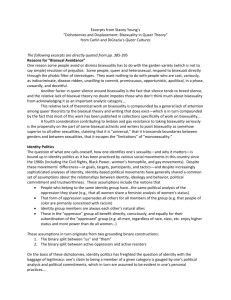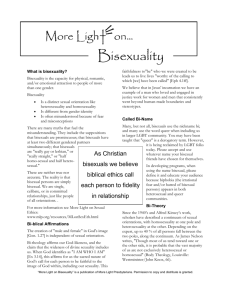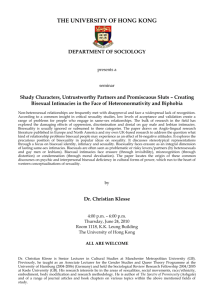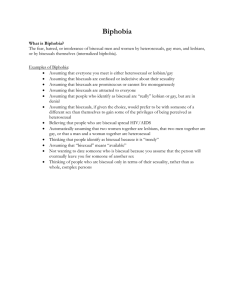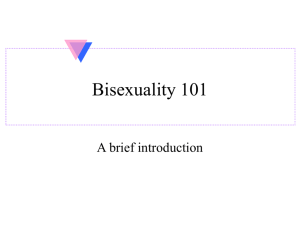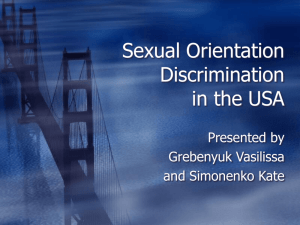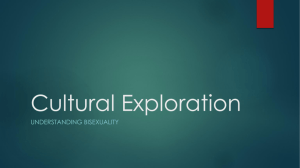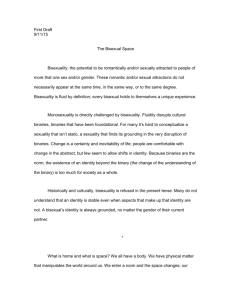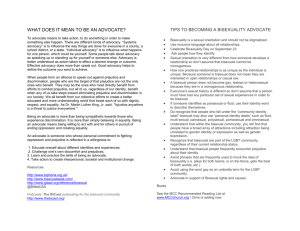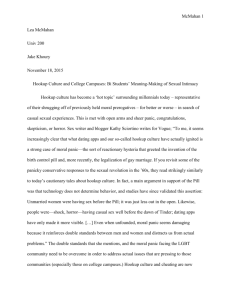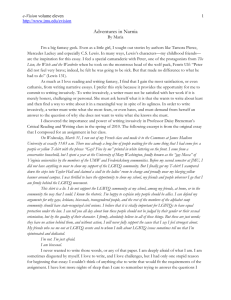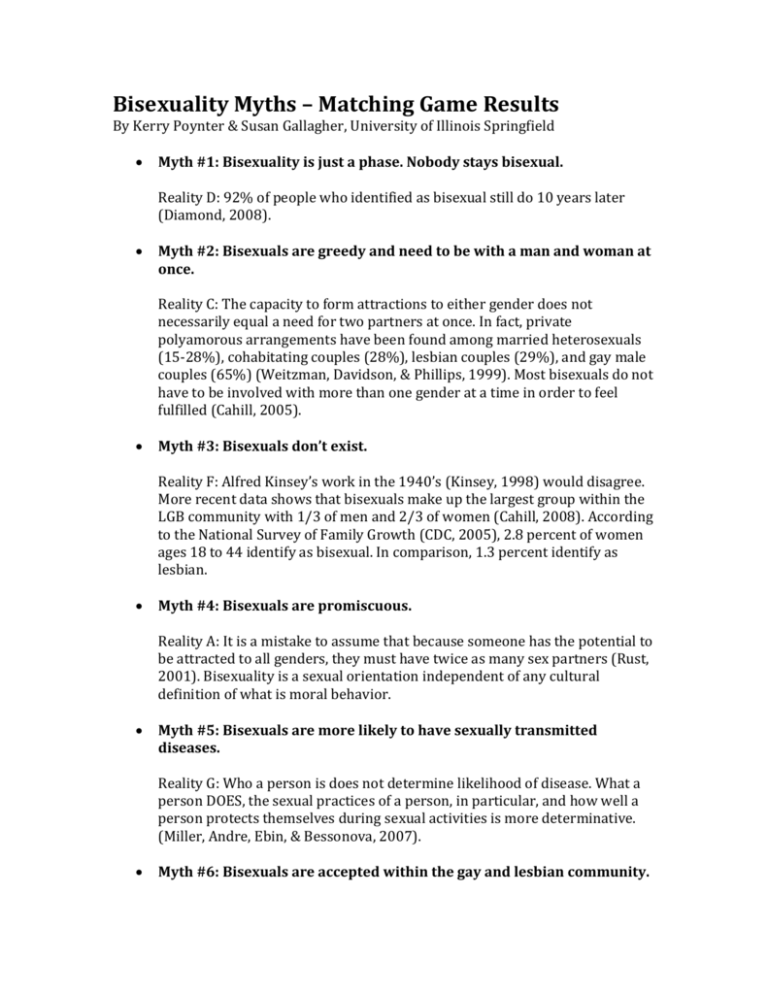
Bisexuality Myths – Matching Game Results
By Kerry Poynter & Susan Gallagher, University of Illinois Springfield
Myth #1: Bisexuality is just a phase. Nobody stays bisexual.
Reality D: 92% of people who identified as bisexual still do 10 years later
(Diamond, 2008).
Myth #2: Bisexuals are greedy and need to be with a man and woman at
once.
Reality C: The capacity to form attractions to either gender does not
necessarily equal a need for two partners at once. In fact, private
polyamorous arrangements have been found among married heterosexuals
(15-28%), cohabitating couples (28%), lesbian couples (29%), and gay male
couples (65%) (Weitzman, Davidson, & Phillips, 1999). Most bisexuals do not
have to be involved with more than one gender at a time in order to feel
fulfilled (Cahill, 2005).
Myth #3: Bisexuals don’t exist.
Reality F: Alfred Kinsey’s work in the 1940’s (Kinsey, 1998) would disagree.
More recent data shows that bisexuals make up the largest group within the
LGB community with 1/3 of men and 2/3 of women (Cahill, 2008). According
to the National Survey of Family Growth (CDC, 2005), 2.8 percent of women
ages 18 to 44 identify as bisexual. In comparison, 1.3 percent identify as
lesbian.
Myth #4: Bisexuals are promiscuous.
Reality A: It is a mistake to assume that because someone has the potential to
be attracted to all genders, they must have twice as many sex partners (Rust,
2001). Bisexuality is a sexual orientation independent of any cultural
definition of what is moral behavior.
Myth #5: Bisexuals are more likely to have sexually transmitted
diseases.
Reality G: Who a person is does not determine likelihood of disease. What a
person DOES, the sexual practices of a person, in particular, and how well a
person protects themselves during sexual activities is more determinative.
(Miller, Andre, Ebin, & Bessonova, 2007).
Myth #6: Bisexuals are accepted within the gay and lesbian community.
Reality B: Lesbian, gay, trans, and heterosexual people harbor
misinformation and biphobia (Welzer-Lang, 2008). Heterosexual people may
consider bisexuals as “confused” while lesbian and gay people will not see
bisexuality as a valid sexual orientation due to stigma around sexual
“preference” as a choice.
Myth #7: Everybody is bisexual.
Reality E: Although it is completely possible for people to experience an
attraction for someone of the same gender at some point in their lives (Fox,
1995), this myth confuses fantasy/attraction for experience and identity. For
most people these feelings pass or change over time without the person ever
questioning or redefining their sexual orientations.
References
Cahill, S. (2005). Bisexuality: dispelling the myths. National Gay and Lesbian Task
Force Policy Institute: Washington, DC. Accessed on July 18, 2012 at
http://www.thetaskforce.org/downloads/reports/BisexualityDispellingtheMyths.pdf.
Centers for Disease Control (2005). National Survey of Family Growth: Sexual
behavior and selected health measures: Men and women 15-44 years of age, United
States, 2002, retrieved July 19, 2012 from www.cdc.gov/nchs/data/ad/ad377.pdf.
Diamond, Lisa M. (2008). Female Bisexuality From Adolescence to Adulthood:
Results From a 10-Year Longitudinal Study. Developmental Psychology, Vol. 44 (No.
1).
Fox, R. (1995). Bisexual Identities, In D’Augelli, A. & Patterson, C. (Eds.). Lesbian, Gay
and Bisexual Identities Over the Lifespan : Psychological Perspectives. New York:
Oxford University Press.
Kinsey, A. (1998) Sexual Behavior in the Human Male, Bloomington IN: Indiana
University Press.
Miller, M., Andre, A., Ebin, J., & Bessonova, L. (2007). Bisexual health: An introduction
and model practices for HIV/STI prevention programming, National gay and lesbian
task force policy institute, The Fenway Institute at Fenway Community Health,
BINET USA, Accessed on July 19, 2012 from
http://www.thetaskforce.org/reports_and_research/bisexual_health.
Mosher, W., Chandra, A., & Jones, J. (2005, September 15). Sexual behavior and selected
health measures: Men and women 15-44 years of age, United States, 2002. Advance Data
from Vital Health and Statistics. Number 362. Hyattsville, MD: U.S. Department of
Health and Human Services, Center for Disease Control and Prevention, National Center
for Health Statistics. http://www.cdc.gov/nchs/products/pubs/pubd/ad/361370/ad362.htm. Accessed July 19, 2012.
Rust, P. (2001). Two Many and Not Enough: The Meanings of Bisexual Identities.
Journal of Bisexuality. 31: 58.
Weitzman, G., Davidson, J, Phillips, R. A. (1999, March). What psychology
professionals should know about polyamory, Paper presented at the 8th annual
diversity conference, New York: Albany. Retrieved on July 19, 2012 from
https://ncsfreedom.org/images/stories/pdfs/KAP/2010_poly_web.pdf.
Welzer-Lang, D. (2008). Speaking Out Loud About Bisexuality: Biphobia in the Gay
and Lesbian Community. Journal of Bisexuality, 8, 81-95.

